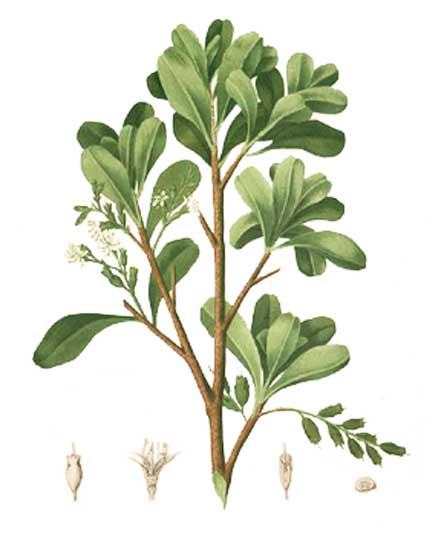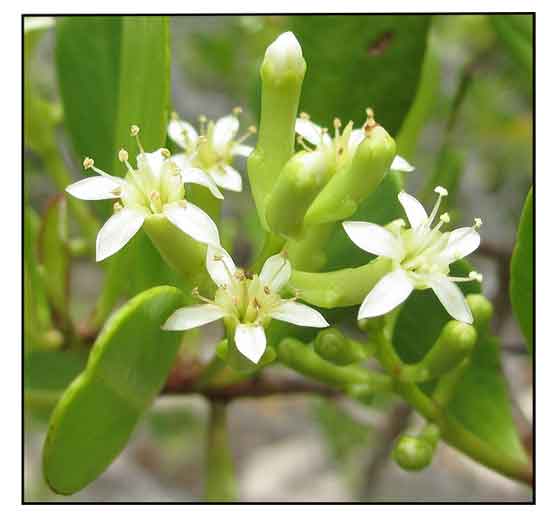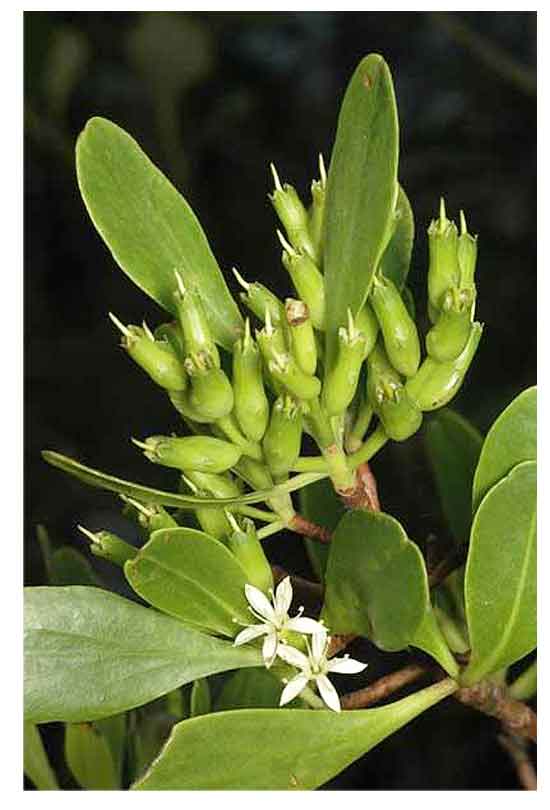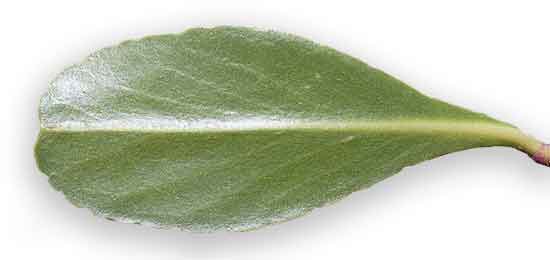
General info
• Lumnitzera is a Indo-West Pacific mangrove genus in the family Combretaceae.
• The genus has two species of similar vegetative appearance with different flower colors: Lumnitzera racemosa has white flowers while L. littorea has red flowers. Both have flat and spoon-shaped (spathulate) leaves with emarginate tips.  (21)
• Etymology: The genus was named after the German botanist, Stephan Lumnitzera (1750-1806). The specific epithet racemosa derives from Latin, referring to the plant's flowering shoot, which consists of a central axis with stalk flowers along it, the youngest at the tip, the older ones lower.
 Botany Botany
• Kulasi is a tree reaching a height of 18 meters, flowering when 1 meter high or less. Air-roots are few in number. Leaves are fleshy, green, shining, narrowly obovate, 2.5 to 7 centimeters long, with rounded and notched tip and pointed base. Flowers are bright scarlet, about 8 millimeters long. Calyx is oblong-cylindric, green, 5 to 6 millimeters long, and short-toothed. Petals are white, oblong, about 4 millimeters long. Stamens are 10, as long as the petals. Fruit is green, woody, oblong, 1.5 to 2 centimeters long, and crowned by persistent calyx-rim, containing a single seed.
• Lumnitzera racemosa is a shrub, or tree up to 8 m tall, without the knee-shaped, upright breathing roots (pneumatophores) at its base. Foliage: Leaves are spirally arranged, almost stalkless, with fleshy leaf blades that are usually narrowly drop-shaped, and 2–9 by 1–2.5 cm. with wedge-shaped bases. Flowers: Stalkless white flowers are fragrant, and found on flowering shoots from the leaf axils. Fruits: Fruits are blackish-brown when ripe, oval or egg-shaped, slightly compressed on one side, two- or three-ridged, and 10–12 by 3–8 mm.
Distribution
- Native to the Philippines.
-
In beach swamps and along tidal streams in Rizal, Bataan and Quezon Provinces; and in Mindoro, Panay, Negros, Cebu and Mindanao.
- Also native to
Aldabra, Andaman Is., Bangladesh, Borneo, Cambodia, Chagos Archipelago, China Southeast, Comoros, Hainan, India, Jawa, Kenya, Korea, KwaZulu-Natal, Lesser Sunda Is., Madagascar, Malaya, Maldives, Maluku, Mozambique, Myanmar, Nansei-shoto, New Caledonia, New Guinea, Nicobar Is., Northern Territory, Queensland, Seychelles, South China Sea, Sri Lanka, Sulawesi, Sumatera, Taiwan, Tanzania, Thailand, Vanuatu, Vietnam, Western Australia. (9)
 Constituents Constituents
- Bark contains 15-19 % tannin; the leaves and wood contain smaller quantities.
- Studies have yielded a long-chain rubber like polyisoprenoid alcohol from the leaves, flavonoids and long chain fatty acids and low molecular weight carbohydrates.
- Study reported friedeline, ß-amyrin, taraxerol, betulin, ß-sitosterol, and triacontanol.
- Crude methanolic extract and fractions yielded flavonoids, quercetin and myricetin as main active components, together with quercitrin, quercetin-3O-hexoside, kaempferol 4'-methyl ether, kaempferol-3,4'dimetheyl ether, and bi-isorhamnetic and myricetin-7O-methylether(3-8")quercetin-2O-rhamnoside. (see study below) (2)
- Study isolated a new aromatic ester, 3-(4-hydroxyphenyl)-propyl-3-(3,4-dihydroxyphenyl)-propionate, together with known triterpenoids, friedelin, betulin,
 and betulinic acid. (5) and betulinic acid. (5)
-
Phytochemical screening of EtOAc fraction of MeOH extract of leaves isolated 8 compounds: a new cyclic compound together with seven known compounds viz. 3,4-dihydroxy benzoic acid, 3, 3,4,5-trihydroxybenzoic acid methyl ester, Loliolide, Quercetin-3-O-(2''-O-galloyl)-rhamnopyranoside, Myricetin 3-O-(2''-O-galloyl)-rhamnopyranoside, Sophoretin, Lyoniresinol. (see study below) (14)
- Phytochemical screening of
aqueous extract of leaves yielded phenols, flavonoids, alkaloids, terpenoids, sterols, tannins, carbohydrates, cardiac glycosides, saponins, and quinones, with an absence of proteins and amino acids. (see study below) (17)
- Study of EtOAc layer from methanolic extract further partitioned with n-hexane and 75% MeOH isolated a new compound, racelactone (1), along with seven known compounds: botulin (2), 3,4,3'-tri-O-methyl ellagic acid (3), methyl gallate (4), myricitrin (5), stigmasterol (6), kaempferol (7), and isoguaiacin (8). (see study below) (18)
- Study of n-BuOH fraction of L. racemosa isolated one new flavonoid glycoside, myrcetin 3-O-methyl glucuronate (1), one new phenolic glycoside, lumniracemoside (2), and one new alipathic alcohol glycoside, n-hexanol 1-O-rutinoside (3), along with seven known compounds (4-10). (see study below (19)
- Phytochemical analysis of stem extracts in different solvents yielded alkaloids, flavonoids, glycosides, phenols, saponins, steroids, terpenoids, tannins, and anthraquinones. (see study below) (20)
Properties
- Studies have suggested antibacterial, antioxidant, cytotoxic, hepatoprotective, antihypertensive , antiplasmodial, phytoremediative, antiangiogenic, anti-inflammatory, sperm immobilizing, carbon sequestrating/accumulating, anticancer, apoptotic properties.
Parts used
Leaves, stems, twigs.
 Uses Uses
Edibility
- Leaves used as forage.
Folkloric
- Fluid substance made from incisions in the stem, mixed with coconut oil, used as anti-herpetic and as cure of itches.
- Elsewhere, used for treatment of diabetes.
Others
- Wood: Used for piles, poles, house posts, ties, paving blocks, bridges, ship planks, decks, handles and cabinetry.
- Fuel: Wood used as fuel for its caloric value. (•) In Cambodia, highly favored for charcoal making.
- Tanning: Bark used for tanning.
- Forage: Leaves are edible; consumed by herbivores of Western Pacific Islands in times of food scarcity.
Studies
• Antihypertensive / Corilagin and Chebulinic Acids: Study investigated the antihypertensive activity of eleven hydrolyzable tannins from the leaves of LR. Corilagin and chebulinic acid were identified as the major active substances. (1)
• Antibacterial / Phenolics: Study investigated phenolics and antimicrobial activity of L racemosa against fungi, virus and pathogenic bacteria. The crude methanolic extract and n-butanol fraction exhibited significant bacterial activity against all the bacterial tested, without activity against fungi and virus. Myricetin showed the most potent activity against Pseudomonas aeruginosa with marked activity against others. (see constituents above) (2)
• Punicalagin / Orthostatic Hypotension Reversal: Punicalagin, an active principle isolated from the leaves of L racemosa reversed the fall in arterial blood pressure in conscious Wistar rats with orthostatic hypotension induced by hexamethonium. It was found less effective in prazosin-induced orthostatic hypotension. The effect is probably from a direct release of NE (norepinephrine) from the noradrenergic nerve terminals by punicalagin. (3)
• Hepatoprotective / Antioxidant / Leaves: Leaf extract of Lumnitzera racemosa was evaluated for hepatoprotective and in vitro antioxidant activity in CCl4-treated rats. Results showed a hepatoprotective effect attributed to the presence of phenolic groups, terpenoids and alkaloids and in vitro antioxidant properties. (4)
• Wastewater Treatment: Study evaluated three mangrove species, i.e., Lumnitzera racemosa, Avicennia marina and Rhizophora stylosa for use in wetland wastewater treatment systems. Lumnitzera was found to increase salinity. It also performed well on total nitrogen removal efficiency testing, and fair on phosphorus removal. (7)
• Antibacterial: Study investigated the antibacterial activity of crude aqueous and ethanol extracts of mature leaves, tender leaves, bark and shoot of various mangrove species against clinical isolates of Shigella sp., Pseudomonas sp., and antibiotic resistant bacteria, Staphylococcus aureus and Proteus sp. Luminitzera racemosa showed the most significant antibacterial activity. (8)
• Antioxidant / Leaves and Stems: Study investigated the antiradical and reducing power activities of methanol extract of leaves and stems of Lumnitzera racemosa. Results showed better antioxidant activity by DPPH and reducing power assay in leaves than stems. Scavenging activity in leaves was 23.31 µg/mL while stems showed 111.5 µg/mL compared to ascorbic acid at 14.98 µg/mL. (10 )
• Cytotoxicity / Antioxidant / Leaves: A methanol extract, Ch2Cl2 and n-BuOH fractions exhibited potent antioxidant activity. Isolated compounds exerted potent cytotoxicity in HL-60 cells, with IC50 values of 0.15 ±0.29 and 0.60 ±0.16 µM. Study of cytotoxic mechanisms included measurement of time-dependent changes in apoptotic markers and downregulation of p-ERK1/2, p-AKT, and c-Myc levels. (11)
• Antimicrobial / Leaves: Study evaluated the antimicrobial activities of various leaf extracts of Lumnitzera littorea against six human pathogenic microbes. Results showed antimicrobial activity with increasing concentration. The n-hexane extract was the most effective. (12)
• Anticancer: Study evaluated the in vitro anticancer activity of crude methanol extracts of four selected mangrove plants viz. Brugiera gymnorrhea, Aegiceras corniculatum, Aegialitis rotundifolia, and Lumnitzera racemosa against HepG2 cell line using MTT assay. All four extracts showed anticancer activity. L. racemosa showed an IC50 of 195.1. (13)
• Hepatoprotective / Acetaminophen Induced Toxicity / Antioxidant / Leaves: Phytochemical screening of EtOAc fraction of MeOH extract of leaves isolated 8 compounds. Compound 8 showed high hepatoprotective activity against acetaminophen and compound 1 showed moderate activity compared to glycyrrhizin as positive control using HepG2 cell line. Compounds 2, 3, 4, 5, 6, and 8 showed highest DPPH radical scavenging activity. (see constituents above) (14) Study of an n-BuOH fraction of L. racemosa isolated 10 compounds: one new flavonoid glycoside, one new phenolic glycoside, one new alipathic alcohol glycoside, along with seven known compounds. Compound 7 showed the highest hepatoprotective activity against acetaminophen-induced hepatotoxicity using human HepG2 cells. Almost all of the compounds showed stronger DPPH radical scavenging activity compared with standard Trolox. (19)
• Antiplasmodial / Leaves: A study evaluated the ethanolic extracts of 10 mangrove plants for in vitro antiplasmodial activity against chloroquine-sensitive Plasmodium falcifarum. The bark extract of R. mucronata (62.18 µg/ml) and leaf extract of L. racemosa (110.93 µg/ml) showed minimum level of IC50 values at significant (p<0.05) levels. (15)
• Antioxidant / Cytotoxicity / Leaves: Study of methanolic extract of mangrove L. racemosa leaves yielded 36 compounds. The methanolic extract, CH2Cl2 and n-BuOH fractions exhibited potent antioxidant activity with Trolox equivalent values of 24.94±0.59, 28.34±0.20, and 27.09±3.37, respectively. The isolated compounds also exhibited dose dependent cytotoxic effects, with compounds 1 and 14 showing most potent cytotoxicity in HL-60 cells with IC50 of 0.15±0.29 and 0.60±0.16, respectively. (16)
• Antioxidant / Anticancer / Anticoagulant / Leaves: Study evaluated the phytochemical composition, antioxidant, anticancer, and anticoagulant activities of aqueous extracts of roots of Acanthus ilicifolius and Lumnitzera racemosa leaves. The leaf extract of L. racemosa showed good antioxidant power as evidenced by an efficient DPPH free radical scavenging, with a lower IC50 of 38.89 µg/ml, in fair proximity to standard ascorbic acid at 21.71 µg/ml. In cytotoxic efficacy testing against HepG2 cancer cell line using MTT assay, L. racemosa showed an IC50 value of 26.05 µg/ml. On anticoagulant testing, the extracts also showed slight prolongation of coagulation times, suggesting inhibition of the common pathway, although not as effective as Heparin. (see constituents above) (17)
• Racelactone / Antiangiogenic / Anti-Inflammatory / Leaves and Twigs: Study of methanolic extract of leaves and twigs isolated one new neolignan, racelactone A (1), along with seven known compounds (2-8). Compound 1 exhibited antiangiogenic effect by suppressing tube formation. Compounds 1, 4, and 5 showed significant anti-inflammatory effects with IC50s of 4.95 ± 0.89, 1.95 ± 0.40, and 2.57 ± 0.23 µM, respectively. (see constituents above)(18)
• Antibacterial
Against Drug Sensitive and Multiple Drug Resistant Bacterial Strains / Stem: Study evaluated the antibacterial activity of L. racemosa stem extract against clinically important drug resistant strains (S. aureus, B. subtilis, B. cereus, E. coli, and K. pneumonia) and drug sensitive strains (B. subtilis, E. aerogenes, and P. aeruginosa). All crude extracts showed antibacterial activity against drug resistant and drug sensitive test cultures, varying from one extract to another in terms of zone of inhibition. ZOI was compared with standard broad spectrum antibiotic Gentamycin. (see constituents above) (20)
• Effect on HeLa Cell Viability / Leaves: Cervical cancer is a malignant process of the cervix, 95% estimated to be caused by HPV (Human Papilloma Virus). Study evaluated the effect of L. racemosa mangrove extract on HeLa cell viability using leaf powder extracted by graded maceration. Results showed an LC50 of 56 ppm, meaning the extract has toxic properties. Extract yield was 11.58%, with water content of 22.17%, and total phenol of 2742.17 mg GAE. LC-MS study yielded suspected compounds of pyrogallol, isoniazid and caffeine. Phytochemical screening of the leaf extract yielded alkaloids, steroids, triterpenoids, and saponins. The ethanolic extract was cytotoxic to viability of HeLa cells with IC50 value of 493.33 µg/mL. (22)
• Sperm Immobilization Effects / Leaves: A leaf methanol extracts was used to assess sperm immobilization activity in measures of time (15 to 240 sec) and concentration (0.15 to 50 g). At 5 g, there was 90% suppression of sperm motility, while at 10 and 50 g it showed 100% inhibition. The activity was attributed to sperm plasma membrane breakdown. Results suggest potential as antifertility drug for birth control. (23)
• Carbon Accumulation / Sequestration: Carbon accumulation/sequestration by plants is a major function that contributes to the removal of carbon dioxide from the atmosphere, which depends on plant species and environmental conditions. Study evaluated two true Sri Lankan mangrove species, i.e. Lumnitzera racemosa Willd. (ten trees) and Bruguiera gymnorrhiza (fourteen trees) with respect to their carbon retention capacity. A positive correlation (p<0.01) and non-linear relationship was revealed between dbh (diameter at breast height) and biomass. The average amount of carbon retained by L. racemosa was 9.16 kg/tree or 9.44 t/ha while that of B. gymnorrhiza was 5.6 t/ha., despite its greater capacity for individual carbon retention (13.76 kg/tree) due to relatively low density and basal area. L. racemosa contains higher percentage of carbon in the stems, branches and roots, revealing superior contribution to carbon-sink function of mangrove ecosystems. (24)
• Photoactivated Extracts against Human Mammary Adenocarcinoma MCF-7 Cells: Study evaluated three plant extracts viz. L. racemosa, Albizia procera, and Cananga ordorata for potential as sourced of photosensitizers in photodynamic therapy. MCF-7 cells were treated with plant extracts, which were irradiated with 5.53 mW and 0.553 mW broadband light. The crude extracts were nontoxic against cancer and non-cancer cells but when irradiated with 5.53 mW of broadband light, L. racemosa and A. procera showed cytotoxicity against MCF-7 with IC50s of 11.63 and 10.73 µg/mL, respectively. Using 0.553 mW broadband light, the IC50s were higher at 17.14 and 19.59 µg/mL. The photoactivated extracts were more cytotoxic against MCF-7 than non-cancer cell line, human dermal fibroblast-neonatal. The cytotoxicity of the extract was mediated by apoptosis. (25)
Availability
- Wild-crafted.
- Ornamental cultivation.
|

![]()




 Botany
Botany


